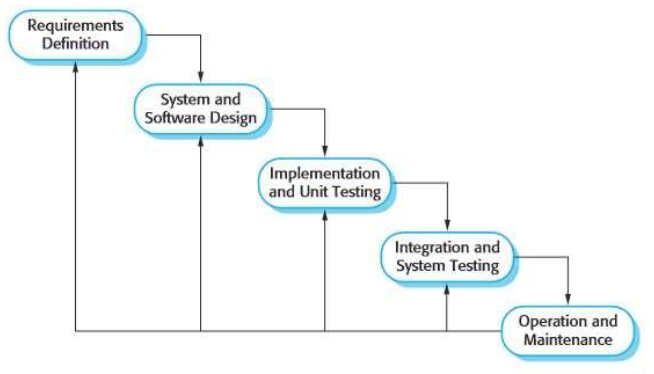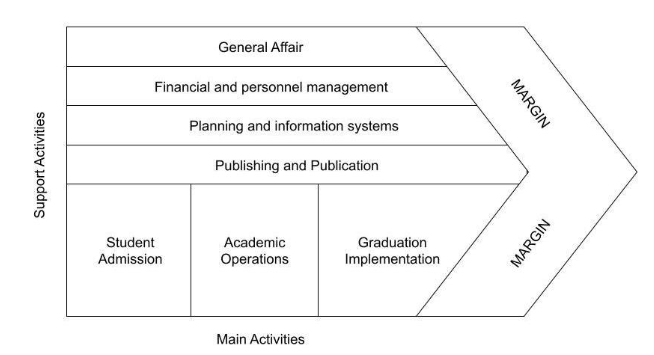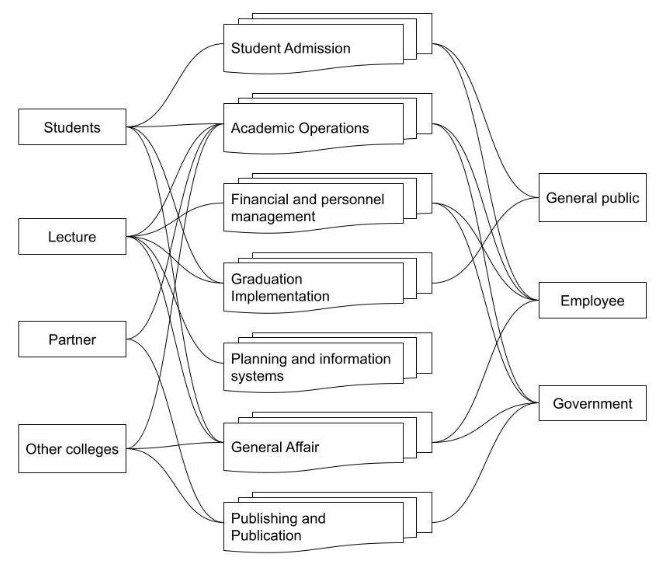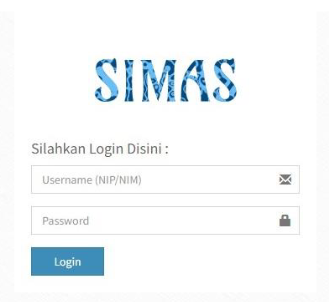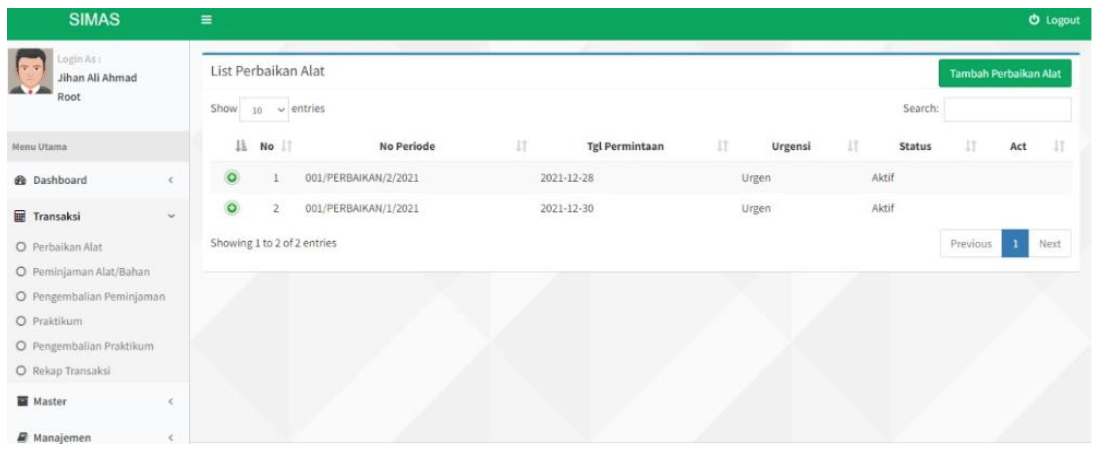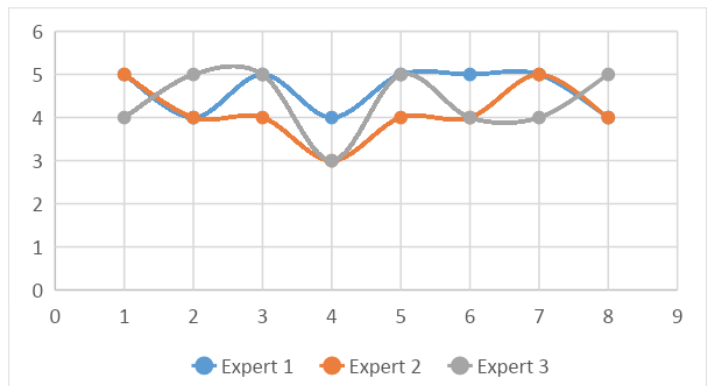Journal:The modeling of laboratory information systems in higher education based on enterprise architecture planning (EAP) for optimizing monitoring and equipment maintenance
| Full article title | The modeling of laboratory information systems in higher education based on enterprise architecture planning (EAP) for optimizing monitoring and equipment maintenance |
|---|---|
| Journal | Matrix: Jurnal Manajemen Teknologi Dan Informatika |
| Author(s) | Ifriza, Yahya N.; Veronika, Trisni W.; Suryarini, Trisni; Supriyadi, Antonius |
| Author affiliation(s) | Universitas Negeri Semarang |
| Year published | 2023 |
| Volume and issue | 13(1) |
| Page(s) | 1–11 |
| DOI | 10.31940/matrix.v13i1.1-11 |
| ISSN | 2580-5630 |
| Distribution license | Creative Commons Attribution 4.0 International |
| Website | https://ojs2.pnb.ac.id/index.php/MATRIX/article/view/928 |
| Download | https://ojs2.pnb.ac.id/index.php/MATRIX/article/view/928/516 |
Abstract
The laboratory is a place to conduct scientific research, experiments, measurements, or scientific training. Fakultas Matematika dan Ilmu Pengetahuan Alam, Universitas Negeri Semarang (FMIPA UNNES) has several laboratories distributed in each department to support student lectures. Through the implementation of practicum in the laboratory, students are expected to be able to find a concept, as well as foster scientific attitudes and critical thinking skills. Good laboratory management is expected to be able to utilize laboratory resources effectively and efficiently. Laboratory equipment must be ensured to function properly and be ready to be used for practicum. To support this, it is necessary to monitor the condition of the equipment and immediately repair the equipment if any damage is found. The current obstacle is monitoring tool repairs manually, so there are shortcomings such as poor documentation and equipment conditions that cannot be monitored online.
In this study, an information system for monitoring the maintenance of laboratory equipment in the departments in the FMIPA UNNES environment will be built. The research method begins with a literature study, initial data collection and observation, enterprise architecture planning (EAP)-based system design, system testing, system analysis, and system evaluation. This study uses the systems development life cycle (SDLC) approach to develop a monitoring information system for the maintenance of laboratory equipment. Testing is done using black box testing. From the results of development and testing, it can be concluded that the system can be used to simplify the process of managing laboratory equipment with a user acceptance testing (UAT) value of 88% suitable for use.
Keywords: enterprise architecture planning, information systems, laboratory, maintenance, optimization
Introduction
A laboratory is a place to conduct scientific research, experiments, measurements, or scientific training. Now lab management has followed technological developments, through to the application of information management systems. This is because technology can facilitate human work. One of them is the existence of digital applications. Applications have various capabilities to help human work, ranging from office applications to management, personal, entertainment, and other fields of human work. With this equipment, human tasks become easier, faster, more thorough, and more efficient.[1]
The implementation of lecture practicum in the laboratory is expected so that students can find a concept and then foster scientific attitudes and critical thinking skills. As such, laboratory management needs to be empowered effectively and efficiently.[2] Laboratory equipment must be ensured to function properly and be ready to be used for practicum. To support this, it is necessary to monitor the maintenance of the equipment systematically. The current obstacle is that monitoring of tool repair is done manually, so there are shortcomings such as poor documentation and being able to track the condition of equipment that cannot be monitored online.[3]
Currently, the Fakultas Matematika dan Ilmu Pengetahuan Alam, Universitas Negeri Semarang (FMIPA UNNES) laboratory does not yet have an information management system that can monitor the maintenance of laboratory equipment, starting from the condition of laboratory equipment to the repair process if there is damage.[4] Therefore, this study aims to create and implementan information system for monitoring the maintenance of laboratory equipment in the Department of Mathematics and Natural Sciences. Based on the description of the importance of laboratories to supporting lectures, the authors initiated the idea of researching the development of information systems that could monitor laboratory equipment maintenance.[5] This is in-line with the recommendation of the Minister of Administrative and Bureaucratic Reform (PANRB), which implies the use of IT and modern tools in completing work.[6] This monitoring system aims to perform two purposes at once, namely preventing laboratory equipment from being lost or damaged and making it easier for laboratory technicians to carry out maintenance of laboratory equipment.[7]
Methodology
The stages in this research are data collection, analysis and design, stages of developing laboratory systems, and testing information systems.[8] The stage of data collection is done by using the method of interview and observation.[9] Interviews were conducted with lecturers, students, and department managers to obtain an overview of the needs and flow of laboratory management. Meanwhile, observations were made by observing what data would be used in the management, borrowing, and processing of laboratory equipment at FMIPA UNNES.[10]
The system design stage was carried out using the Waterfall method. The Waterfall method is a sequential software development method and consists of five interrelated and influencing stages.[11][12] With this method, there are several stages, namely the analysis, design, implementation/coding, testing/verification, and maintenance stages. The stages of the Waterfall method are shown in Figure 1.
|
At the system design stage, a design was produced for the database using entity-relationship diagrams (ERDs) and data flow diagrams (DFDs) to describe the system framework that would later be built, making it easier to make the system needed by the user.[13] The development stage implemented the results of the design carried out. The information systems development process used the CodeIgniter framework with the PHP and JavaScript programming languages. The next stage of this research involved testing the information system for bugs using the black-box testing method. This test was carried out to find out what deficiencies and errors are in the system.[14] The system was also tested by the end users by attempting to conduct experiments directly using the system. This user testing was carried out using black-box testing and a mean opinion score (MOS). In this case, black-box testing checks one by one the functions that have been created, and whether they have been made in accordance with user requirements.[15] The MOS test involves several respondents who are encouraged to use the system, then afterwards asking them to assess several activities with a range of one to four, where a value of one represents the worst value and a value of four represents the best value. Then the average rating of all respondents was calculated so that the MOS is obtained for the system.[16]
Enterprise architecture (EA) is a logical organization for the main business processes and information technology (IT) capabilities that reflect the need for integration and standardization of the company's operating model based on the Center for Information Systems Research.[17] EA is a set of principles, methods, and models used in the design and realization of a company's organizational structure, business processes, information systems, and infrastructure.[18] Enterprise architecture planning (EAP) is a process of defining the architecture for the use of information to support the business and planning to implement the architecture.[19][20][21]
EAP methodologies and models are an early part of a major body of EA knowledge that is still relevant and has influenced many frameworks, methodologies, and best practices in the public and private sectors.[22][12] As such, the research methodology used herein was adapted to the architectural modeling steps of EAP, namely planning initiation, business modeling, current system architecture and technology, development of EA models in the form of data architecture, application architecture, technology architecture, and implementation.[23]
Results and discussion
The end result of this research has been an information system for the management of laboratory equipment. This system can be used to simplify the process of data collection, borrowing, and also processing the value of laboratory equipment results. The modeling steps of the EAP were taken into account when building a blueprint for the system architecture. Following the steps of the EAP concept, the system was used to model the laboratory system at FMIPA UNNES. However, this implementation required initial EAP-related planning, business modeling, system architecture and technology consideration, development of an EA model, and implementation and testing of the system.
Initial planning
The users of this system were to be department laboratory administrators, who are tasked with inputting lab asset data in their respective departments, including conditions and suggestions for repairing tools. Also involved with initial planning were faculty administrators, who are tasked with making decisions about whether to approve or postpone the proposed repairs, and financial administrators, who are tasked with approving budget allocations/ceilings.
The initial stage of the EAP is planning, which defines the organization as an object by describing the organization's vision and mission, which is linked to the vision associated with information system planning, so that the development of the architecture can be carried out in accordance with business objectives. In accordance with its existence as a university, the core business of a university consists of three main components, namely education and teaching, community service, and research, which make up the Tri Dharma Perguruan Tinggi (Tri Dharma) of higher education. In return for providing educational services to the community, graduates will return to the community with greater purpose. Determining the future vision and mission is necessary as a guideline for determining various IT strategies needed to support the vision and mission. The selection of the planning methodology approach determines the results of the blueprint that is ultimately made.
The primary vision and mission of FMIPA UNNES is to develop mathematics and natural science education in superior educational and non-educational programs with conservation insight and positive international reputation. Second, FMIPA UNNES seeks to develop and create science and technological innovation in the fields of mathematics and natural sciences, as well as civilizations with conservation insight and international reputation. Third, the department seeks to have that science and technological innovation disseminate more broadly into the fields of mathematics and natural sciences. Fourth, the departments seeks to build and develop institutional cooperation in supporting the institutional strengthening of the department's international reputation.
The goal of FMIPA UNNES is to develop students of mathematics and natural sciences that are superior at the international level, with superior conservation insight. The department can do this by providing modern professional education services in the field of mathematics and natural sciences to the community, and implementing cooperation in the field of mathematics and natural sciences to support the strengthening of institutions of international reputation.
Business modeling
The inherent organizational structure within universities provides the impetus for conducting business modeling. The organizational structure will show what parts will be handled by a university. As a higher education institution, it focuses on the educational Tri Dharma of education and teaching, research, and community service. This paper will only discuss the fields of education and research—especially as they relate to laboratories—and not include community service. Based on the value chain concept, the main functional areas for the education model in higher education can generally be grouped into main activities and supporting activities. The main activities consist of student admissions, academic operations, and graduation. Meanwhile, supporting activities consist of activities related to resource management (general), financial management, planning and information systems, and publishing and publication. Figure 2 shows the value chain for a university's education and research model.
|
Each of the main activities in the value chain can be described. First, student admissions are all activities starting from the process of new student admissions and selection of new student administration. Second, academic operations are all activities related to teaching and learning activities during the student's academic period. Third, graduation is an activity to release students academically at the end of student studies.
There is also a variety of support activities. First, the general affairs division is the part responsible for the smooth operation of educational facilities and carries out the development of infrastructure from year to year, for both primary physical facilities and facilities to support educational activities. Second, finance and personnel management are activities that relate to financial management, determination of investment budgets and needs, and monitoring and allocation of human resources. Third, planning and information systems are activities related to the management and development of information system equipment and networks. Fourth, publishing and publication are activities related to the management and publication of journals, bulletins, and student textbooks.
After initiating the organization's business function areas by utilizing Porter's value chain[24], it is possible to arrange the decomposition structure of the business functions using a function hierarchy chart. In accordance with the scope and limitations of this journal, the functions that are decomposed are those related to academics as the main functions with elaboration on student admissions, academic operations, graduation implementation, general division, financial and staffing management, and planning and information systems, as well as publishing and publications. This is depicted in Table 1.
| ||||||||||||||||||
Figure 3 below shows the relationship between stakeholders and the main and supporting business functions in a university.
|
System architecture and technology
Assessing the current information system and technology provides an overview of the current state of information technology and systems, the future development of IT, and the desire and direction of IT development in universities today. In this step, several things need to be considered and used as the main key in conducting the analysis, namely the condition of the organization, the direction of IT development strategy, and the condition of the current information system and technology.
Development of an EA model
In building an architectural model, the first thing to do is create a data architecture. The data architecture that will be defined this time is the definition of the data usage that will be used in the application architecture later, which will be delivered at this stage according to the EAP stage in the data architecture.
An entity candidate is an entity that will be part of the EAP so that the determination can be based on the condition of the main business functions in the previously defined value chain (thus the entity that will be defined as a business entity) and based on the business entity data entities will be defined by. In accordance with the condition of the value chain, the list of business entities and their data entities can be identified as found in Table 2.
| ||||||||||||||
To describe the relationship between entities, the conceptual depiction of the relationship uses an ERD for the laboratory. The ERD is a logical data conceptual model that shows the relationship between entities in laboratories in universities. The last stage in modeling the architecture is defining the technology architecture. The EAP concept defines technology requirements that need to be provided in the business environment to run a data architecture that can manage data based on the application architecture. In other words, the technology architecture is an infrastructure requirement that must be provided to support the running of data and applications used by the organization. The principles and technology platforms were created to identify the main types of technology platforms needed to support shared data and application environments in universities. This principle is determined by considering trends and developments in information technology, business models, data architecture, application architecture, existing systems, and technologies, as well as requests and findings from business people within the organization. Table 3 shows the technology platforms that can be used to support data and applications in universities.
| ||||||||||||||||
Implementation and testing
The laboratory system development stage is the implementation stage of the design stage. At this stage of development, it is done by coding the required pages on the laboratory system using the CodeIgniter framework. Figure 4 shows the results of developing logins. The login page is a page that is used to verify users, and there are username and password inputs that must be filled in by system users to be able to enter the system. If the username and password inputs do not match, then the user cannot enter the system.
|
Admin users who have entered the correct username and password will enter the admin page. Figure 5 is a view of the admin page (Admin Data). On the admin data page, admin users can view, add, and change information, and they can delete admin data.
|
The system testing stage or testing is the stage carried out to match and observe the results of the implementation that has been carried out. System testing or testing was carried out in this study using the black-box method and the MOS. The testing process with the black-box method was carried out by testing one by one the functions that have been made to determine whether they were in accordance with user requirements and whether the output of these functions were in accordance with what was expected. As for MOS testing, it was carried out by subjective assessment of the quality associated with the system. The results of the tests carried out on the website-based Pendadaran Information System using the MOS test method, based on user acceptance testing (UAT), can be seen in Table 4.
| ||||||||||||||||||||||||||||||
We also present expert validity data in the graph of each component, which can be seen in Figure 6.
|
Based on tool validation by UAT experts selected by the research team to validate the laboratory system for system validation sheets, the results of product feasibility from experts show valid and very valid results, starting from A1 with 93% results, and A2 with 87% results. A3 results in 93%, A4 results in 67%, A5 results in 93%, A6 results in 87%, A7 results in 93%, and A8 results in 87%. If the overall validity component is obtained on average, 88% of the products are very valid. These results are presented in the form of Table 4 and Figure 6.
Conclusion
Based on the results of the study, it can be concluded that the use of laboratory systems for monitoring and maintenance in laboratory management has proven to be very valid. Before implementing the laboratory system identification method, laboratory maintenance and tracking tools and materials were still handled manual. However, EAP proves to be an effective approach to modeling laboratory-based information systems in higher education. EAP helps align the business and technology within laboratory-based information systems, making it easier to monitor and maintain equipment. Monitoring and maintenance of laboratory equipment play a critical role in ensuring the quality of collected data. EAP helps ensure that laboratory equipment is functioning properly and strengthens the software system.
Modeling becomes an effective tool for applying the EAP concept in laboratory-based information systems. Modeling helps align the business and technology goals of the organization with the system to be implemented, ensuring the quality of collected data. The implementation of EAP with lab-based information systems in higher education has the potential to increase efficiency and effectiveness in monitoring and maintenance of equipment. It helps ensure that collected data is accurate and of high quality, making it easier to process, analyze, and make decisions about. After implementing the EAP method, the laboratory system is safer, and access to tools and materials can be monitored properly. A test of the validity of our laboratory system for monitoring and maintenance saw an average validity of the expert team reaching 88%, based on tool validation by UAT experts.
Abbreviations, acronyms, and initialisms
- DFD: data flow diagram
- EA: enterprise architecture
- EAP: enterprise architecture planning
- ERD: entity-relationship diagram
- FMIPA UNNES: Fakultas Matematika dan Ilmu Pengetahuan Alam, Universitas Negeri Semarang
- IT: information technology
- MOS: mean opinion score
- PANRB: Minister of Administrative and Bureaucratic Reform
- SDLC: systems development life cycle
- UAT: user acceptance testing
Acknowledgements
The author expresses his gratitude and appreciation to LPPM State University of Semarang for the opportunity given to conduct research on the Functional Tendik scheme in 2022.
Conflicts of interest
None stated.
References
- ↑ Uysal, Murat Pasa; Mergen, A. Erhan (1 June 2021). "Smart manufacturing in intelligent digital mesh: Integration of enterprise architecture and software product line engineering" (in en). Journal of Industrial Information Integration 22: 100202. doi:10.1016/j.jii.2021.100202. https://linkinghub.elsevier.com/retrieve/pii/S2452414X21000030.
- ↑ Pebrioni, N.M.; Iriani, A.; Dwikurnaningsih, Y. (2021). "Development of Vocabulary Training Module Using Games for Vocational English Teachers to Improve Teachers’ Competency". Indonesian Journal of Informatics Education 5 (2): 37-45. doi:10.20961/ijie.v5i2.54534. https://jurnal.uns.ac.id/ijie/article/view/54534.
- ↑ Loft, Paul; He, Ying; Yevseyeva, Iryna; Wagner, Isabel (1 November 2022). "CAESAR8: An agile enterprise architecture approach to managing information security risks" (in en). Computers & Security 122: 102877. doi:10.1016/j.cose.2022.102877. https://linkinghub.elsevier.com/retrieve/pii/S0167404822002711.
- ↑ Darmita, I B G A; Dantes, G R; Candiasa, I M (1 April 2020). "Regional income management information system with Enterprise Architecture Planning Approach (EAP): a case study in BPKPD Klungkung Regency". Journal of Physics: Conference Series 1516 (1): 012016. doi:10.1088/1742-6596/1516/1/012016. ISSN 1742-6588. https://iopscience.iop.org/article/10.1088/1742-6596/1516/1/012016.
- ↑ Afuan, I.; Nofiyati, N.; Ridlwan, A.F. (2022). "Rancang Bangun Sistem Informasi Pengelolaan Pendadaran Menggunakan Framework Laravel". Jurnal Sistem dan Teknologi Informasi 10 (1): 113–122. doi:10.26418/justin.v10i1.45678. https://jurnal.untan.ac.id/index.php/justin/article/view/45678.
- ↑ Ahlemann, Frederik; Legner, Christine; Lux, Johannes (1 January 2021). "A resource-based perspective of value generation through enterprise architecture management" (in en). Information & Management 58 (1): 103266. doi:10.1016/j.im.2020.103266. https://linkinghub.elsevier.com/retrieve/pii/S0378720619302101.
- ↑ Lee, Hsien-Yu; Wang, Nai-Jian (1 May 2019). "Cloud-based enterprise resource planning with elastic model–view–controller architecture for Internet realization" (in en). Computer Standards & Interfaces 64: 11–23. doi:10.1016/j.csi.2018.11.005. https://linkinghub.elsevier.com/retrieve/pii/S0920548918301697.
- ↑ Kurnia, Sherah; Kotusev, Svyatoslav; Shanks, Graeme; Dilnutt, Rod; Milton, Simon (1 June 2021). "Stakeholder engagement in enterprise architecture practice: What inhibitors are there?" (in en). Information and Software Technology 134: 106536. doi:10.1016/j.infsof.2021.106536. https://linkinghub.elsevier.com/retrieve/pii/S0950584921000240.
- ↑ Tavakoli, Mansoor; Tavakol, Mahbube (1 January 2018). "Problematizing EAP education in Iran: A critical ethnographic study of educational, political, and sociocultural roots" (in en). Journal of English for Academic Purposes 31: 28–43. doi:10.1016/j.jeap.2017.12.007. https://linkinghub.elsevier.com/retrieve/pii/S1475158517301364.
- ↑ Putri, Seni; Hayati, Umi; Dzulkarnaen, Rizal (2 March 2020). "Architectural Design of Electronic Medical Record (EMR) using Enterprise Architecture Planning (EAP) Method" (in id). Journal of Information Technology 2 (1): 25–30. doi:10.47292/joint.v2i1.005. ISSN 2656-7539. https://jurnal.stmik-amikbandung.ac.id/joint/article/view/21.
- ↑ Agievich, Vadim; Skripkin, Kirill (2014). "Enterprise Architecture Migration Planning Using the Matrix of Change" (in en). Procedia Computer Science 31: 231–235. doi:10.1016/j.procs.2014.05.264. https://linkinghub.elsevier.com/retrieve/pii/S1877050914004414.
- ↑ 12.0 12.1 Politeknik Unggul LP3M, Indonesia; Purba, Ramen Antonov (28 November 2021). "Application design to help predict market demand using the waterfall method". Matrix : Jurnal Manajemen Teknologi dan Informatika 11 (3): 140–149. doi:10.31940/matrix.v11i3.140-149. https://ojs2.pnb.ac.id/index.php/MATRIX/article/view/39.
- ↑ Tutaj, Jerzy; Rutkowska, Małgorzata; Bartoszczuk, Paweł (2021). "Enterprise Business Architecture as a Tool for Sustainable Development in an Enterprise - case study" (in en). Procedia Computer Science 192: 5050–5057. doi:10.1016/j.procs.2021.09.283. https://linkinghub.elsevier.com/retrieve/pii/S1877050921020226.
- ↑ Liana, V.I.; Dewi, L.P.; Yulia, Y. (2019). "Enterprise Architecture Pada CV. Grande Zangrandi Dengan Metode Enterprise Architecture Planning (EAP)". Jurnal Infra 7 (1): 164–169. https://publication.petra.ac.id/index.php/teknik-informatika/article/view/8066.
- ↑ Supriadi, Hari; Amalia, Endang (10 May 2019). "University’s Enterprise Architecture Design Using Enterprise Architecture Planning (EAP) Based on the Zachman’s Framework Approach". International Journal of Higher Education 8 (3): 13. doi:10.5430/ijhe.v8n3p13. ISSN 1927-6052. http://www.sciedu.ca/journal/index.php/ijhe/article/view/15469.
- ↑ Petrov, Igor; Malysheva, Natalia; Lukmanova, Inessa; Panfilova, Elena (2022). "Transport enterprise architecture and features of its personnel management" (in en). Transportation Research Procedia 63: 1462–1472. doi:10.1016/j.trpro.2022.06.157. https://linkinghub.elsevier.com/retrieve/pii/S2352146522004124.
- ↑ Indrawan, B; Sumitra, I D (1 November 2019). "Enterprise Architecture for Higher Education Using Enterprise Architecture Planning Based Three Pillars of Higher Education". IOP Conference Series: Materials Science and Engineering 662 (3): 032030. doi:10.1088/1757-899X/662/3/032030. ISSN 1757-8981. https://iopscience.iop.org/article/10.1088/1757-899X/662/3/032030.
- ↑ Utomo, Andy Prasetyo (1 April 2014). "PEMODELAN ARSITEKTUR ENTERPRISE SISTEM INFORMASI AKADEMIK PADA PERGURUAN TINGGI MENGGUNAKAN ENTERPRISE ARCHITECTURE PLANNING". Simetris: Jurnal Teknik Mesin, Elektro dan Ilmu Komputer 5 (1): 33–40. doi:10.24176/simet.v5i1.129. ISSN 2549-3108. https://jurnal.umk.ac.id/index.php/simet/article/view/129.
- ↑ Tavana, Madjid; Hajipour, Vahid; Oveisi, Shahrzad (1 September 2020). "IoT-based enterprise resource planning: Challenges, open issues, applications, architecture, and future research directions" (in en). Internet of Things 11: 100262. doi:10.1016/j.iot.2020.100262. https://linkinghub.elsevier.com/retrieve/pii/S2542660520300962.
- ↑ Subagjo, R.T. (2012). "Pemodelan Arsitektur Enterprise STMIK CIC Cirebon Menggunakan Enterprise Architecture Planning". Jurnal Teknik Informatika dan Sistem Informasi 7 (2). https://www.neliti.com/publications/219753/pemodelan-arsitektur-enterprise-stmik-cic-cirebon-menggunakan-enterprise-archite#cite.
- ↑ Pattij, Maurice; van de Wetering, Rogier; Kusters, Rob (2022). "Enhanced digital transformation supporting capabilities through enterprise architecture management: A fsQCA perspective" (in en). Digital Business 2 (2): 100036. doi:10.1016/j.digbus.2022.100036. https://linkinghub.elsevier.com/retrieve/pii/S2666954422000163.
- ↑ Universitas Flores; Tute, Kristianus Jago; Londa, Maria Adelvin; Universitas Flores; Mude, Anastasia; Universitas Flores (31 July 2022). "Delone and McLean Models for measuring the success of Flores University e-learning information system". MATRIX : Jurnal Manajemen Teknologi dan Informatika 12 (2): 68–78. doi:10.31940/matrix.v12i2.68-78. https://ojs2.pnb.ac.id/index.php/MATRIX/article/view/453.
- ↑ Universitas Katolik Musi Charitas, Indonesia; Wibagso, Stefanus Setyo; Celesta, Ivana; Universitas Katolik Musi Charitas, Indonesia (28 November 2021). "Implementation of human-centered design methods in designing application interfaces for nursing home service". Matrix : Jurnal Manajemen Teknologi dan Informatika 11 (3): 150–161. doi:10.31940/matrix.v11i3.150-161. https://ojs2.pnb.ac.id/index.php/MATRIX/article/view/36.
- ↑ Tarver, E. (1 September 2021). "What Are the Primary Activities of Michael Porter's Value Chain?". Investopedia. https://www.investopedia.com/ask/answers/050115/what-are-primary-activities-michael-porters-value-chain.asp.
Notes
This presentation is faithful to the original, with only a few minor changes to presentation. Grammar was cleaned up for smoother reading. In some cases important information was missing from the references, and that information was added. The original article duplicates a paragraph in the methodology, with new references, which is confusing; for this version, the duplicated content was removed, along with the associated references, putting the article at three fewer references. Additionally, no citation was associated with the mention of Porter's value chain (originally mispelled as "Potter's") and a citation was added for this version.
